SEO KPIs: The Essential Metrics Every Marketer Should Track

Anyone doing SEO knows how important and abundant technical and website data is today. Essentially, you can track anything and for anyone, as all actions and inactions that people or search engines do leave digital traces.
The concept of SEO KPIs has emerged straight from this information overload. It helps SEO professionals and businesses who care about their search engine rankings to make sense of their performance and to achieve business-focused results. How? Let’s find out together.
In this post, we’ll explore different SEO key performance indicators, showing what they are, why they matter, and what they measure. If you are still not sure which KPIs to use in your search optimization, read each chapter carefully, and the choice will no longer feel overwhelming or uncertain.
SEO KPIs demystified: What they are and how they differ from metrics
SEO KPIs, or SEO key performance indicators, are measurable data points that are most critical to achieving business objectives. For example, KPIs may be set to measure page views, impressions, bounce rate, number of backlinks, average session duration, and many other SEO parameters.
Many people confuse metrics and KPIs, and often use these two terms interchangeably, as if they are synonyms. However, these two concepts mean different things and have different purposes.
For one, metrics is a more vague and broad term than KPIs. It encompasses everything that can be tracked and measured. Therefore, metrics deal with raw data, but their biggest problem and drawback is that they don’t always connect with business goals. It is a measurement for the sake of measurement, even if it's not in the interest of a business.
KPIs, on the other hand, are always connected to business goals. That’s why they are called KEY performance indicators, underscoring their importance for achieving one’s strategic or operational goals.
For the same token, all KPIs are metrics, but not all metrics are KPIs. Think of KPIs as the elite metrics that bring value for the business and measure only what’s truly important.
Marketers don’t normally present all metrics to the key business stakeholders, like top management or investors. Instead, they track and show how the business performs on KPIs.
Here is a summarizing table to help you distinguish and memorize the differences between metrics and KPIs:
|
Aspect |
Metrics |
KPIs |
Key takeaway |
|
Definition |
Broad data points that can be tracked |
Critical metrics tied to business goals |
All KPIs are metrics, but not all metrics are KPIs |
|
Purpose |
Provide raw measurements without always linking to outcomes |
Measure performance against strategic or operational objectives |
KPIs show direction, metrics just show data |
|
Use in reporting |
Rarely presented to stakeholders |
Regularly reported to management and investors |
KPIs matter for decision-making, metrics for analysis |
8 essential KPIs to track for better SEO
Out of all possible KPIs used in search engine optimization practices, only a few stand out for their universal utility and real impact on SEO performance. In this chapter, we’ll break down eight of such KPIs, explain why each matters, and show how to measure them without fluff.
1. Organic traffic as a core SEO KPI
Compared to the paid ads, SEO is about organic traffic acquisition. In this chapter, we’ll review what it means, what makes it so important, and take a look at some of the most effective ways other people measure this KPI.
What it is
Organic traffic is about all traffic that comes to your blog, website, or social media page as a result of your SEO activities. This KPI is called organic for a reason: people find you through unpaid search results.
It’s nudged by relevance, site speed, internal linking, and link equity. Improve these, and discovery improves.
As a search performance metric, it is an honest barometer of problem–solution fit. If queries match your offers, volume rises.
It’s also a hedge against platform changes. Strong organic visibility softens volatility elsewhere.
Why it matters
Out of all KPIs for SEO, organic traffic measures the essence of what SEO can deliver.
SEO KPIs must be focused on what's important for the business, individual, or organization, and organic traffic is often the core indicator.
Here are the core reasons this success metric matters:
- Sustainable growth: Organic traffic is about reliable and sustainable growth.
- Demand capture: The audience comes to your resource already “warm”, which is a big plus for any business.
- Quality intent: Visitors come from searches that match their true goals.
- Attribution clarity: Organic traffic allows you to separate organic results from paid ads in tracking and reporting.
- Resilience: Performance remains high even when the paid budget suffers.
- Upside for conversion rate optimization: Better-quality visitors make website experiments more reliable.
When organic traffic rises, content, technical fixes, and authority are working together. As a search performance KPI, it connects to rankings, clicks, and conversions downstream.
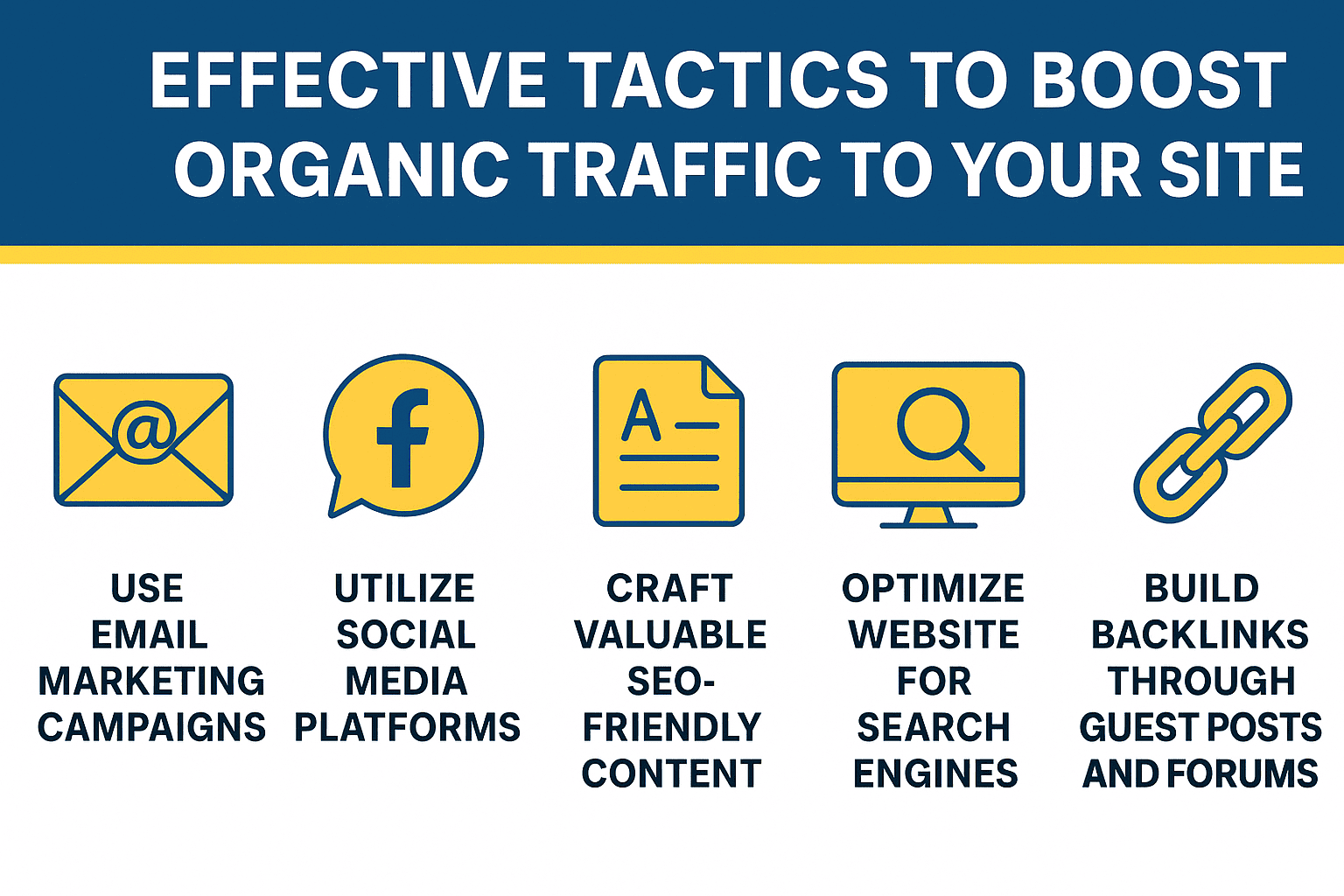
How to measure it
Contrary to the common myth, you don’t need fancy tools to measure organic traffic. Neither do you need expensive tools. A simple Google Analytics version 4 (GA4) will suffice to begin with. It will help you start with a simple, consistent view of this SEO performance indicator.
Follow these simple steps:
- Choose a reliable analytics tool: Use GA4 for sessions and Google Search Console for clicks.
- Segment traffic: Separate traffic by demographics, location, or search intent (e.g., informational, navigational, transactional, etc.).
- Track by landing page: GA4 allows you to see which resources landed your visitors.
- Monitor trends: Compare week-over-week and year-over-year.
- Watch seasonality: Annotate whether the new traffic is a result of launches, holidays, or product/software updates.
- Tie to conversions: Add goals or e-commerce events to organic segments.
- Build a dashboard: Implement ongoing traffic monitoring for continuous insights and informed decision-making.
👉 It helps to evaluate the incoming traffic along with other business-critical indicators. As a search performance metric, organic traffic shines when paired with conversions and revenue.
2. Keyword rankings and visibility
Rankings and visibility are the earliest signs of success that are often used with such a popular marketing concept as MVM (minimum viable marketing — testing what might and might not work early and cheaply). In SEO, they indicate whether searchers can actually encounter your pages.
Handled well, they’re dependable key search engine optimization metrics. They’re simple, understandable, and actionable.
What it is
A ranking is the numeric position of a page for a keyword. It shows where your page appears in search results for a particular keyword. You can apply this testing to all keywords relevant to your industry/niche, and select only those keywords that can deliver the best results.
Visibility aggregates impressions and the breadth of terms you show up for. It indicates whether your content, products, or services get noticed by prospects.
Besides their apparent roles, these search performance KPIs also indicate topical authority growth. They help verify whether your internal linking and content depth are working.
Why it matters
Rankings and visibility are your early “are we findable?” signals. They tell you whether people can realistically bump into your pages before you pour more budget into content or links. Think of them as helpful traffic lights for MVM decisions.
Here are the top benefits of using these KPIs in your SEO campaign:
- Faster clues than conversion data.
- Clear targets for content refreshes.
- Early warnings of technical issues.
- Simple way to brief stakeholders.
- Clear benchmark to track competitors.
When these signals go up, you’re likely on the right track. If they stall, you know where to investigate first — titles, internal links, or intent alignment — right before costs creep up.
How to measure it
Measuring keyword rankings and visibility is best done with specialized SEO tools. Luckily, there is no shortage of those. Tools like Google Analytics, Google Search Console, Ahrefs, SEMrush, and MOZ make tracking simple and effective. All of them have free versions, but for maximum results, we recommend going with one of the numerous paid plans.
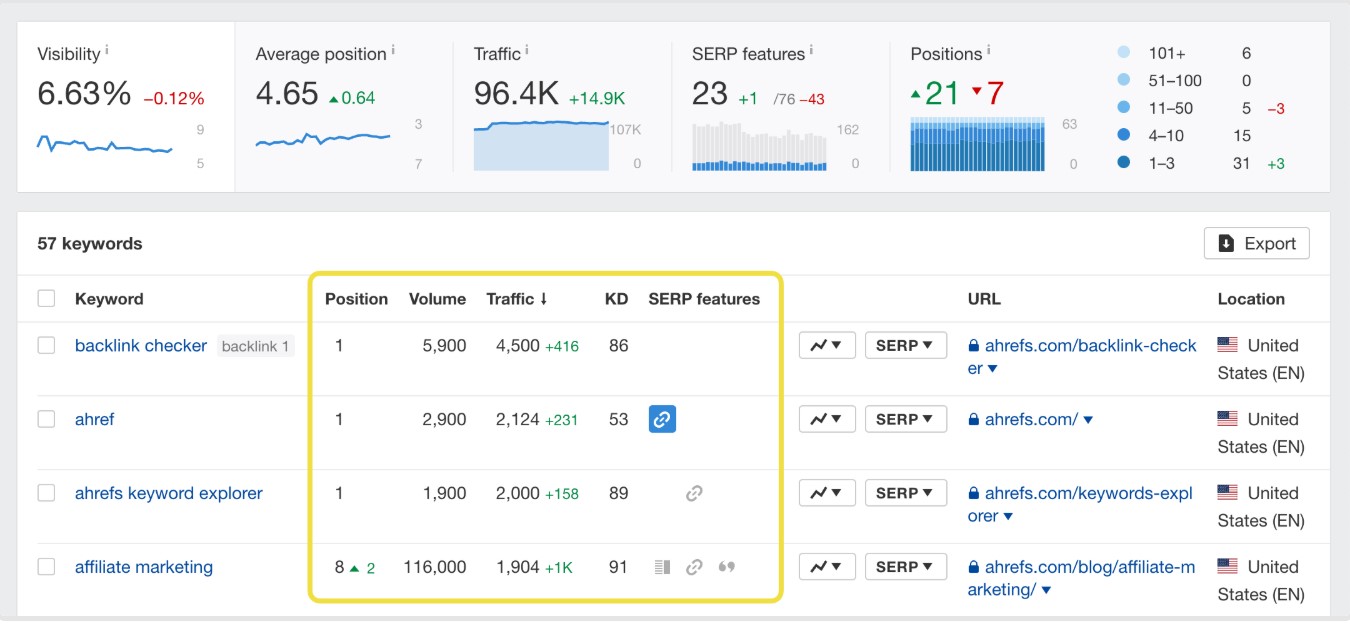
Source: Ahrefs
The key to success is to adopt a simple framework and stick with it. This will help with tracking results over time and selecting the best keywords and tools for every given stage of your business growth.
Here is a simple measurement outline:
- Match every keyword to one specific page and its purpose.
- Check rankings separately for mobile searches and for desktop searches.
- Make sure being seen in results actually brings real clicks.
- Compare how visible your pages are against the main competitors.
- Pay attention to when pages move into top search positions.
- Connect ranking changes directly with leads, sign-ups, or sales outcomes.
Keywords rankings and visibility often stand among the central SEO KPIs, which should be measured early to guide one’s SEO performance and next steps. Therefore, you should make them count by ending with the two or three actions you’ll take into the next search engine optimization stage.
3. Click-through rate from SERPs
Search Engine Results pages (SERPs) are perhaps the most important source of all traffic coming to one’s website. That’s because search engines like Google have billions of active users, and even if a fraction of this audience sees your product or brand in the first SERP, that can potentially yield you thousands of visitors.
SERP traffic is best measured with click-through rate (CTR). It shows how often impressions become visits, making it one of the clearest SEO KPIs for judging relevance and appeal. Track CTR with position to spot weak titles and descriptions, test richer snippets, and prioritize pages for more visibility. In short, CTR turns search visibility into traffic you can grow.
What it is
CTR is the percentage of impressions that result in clicks. It compresses intent, relevance, and presentation into one clear number. In our case with SERPs, it means the percentage of impressions people have upon seeing search engine results pages upon sending their queries, which results in clicks that lead to a particular website or page online.
Among SEO key performance indicators, it’s the fastest read on search engine optimization effectiveness. Copy, structured data, position, and many other elements subject to optimization all influence it.
Click-through rate is a practical gauge of how well you compete line-by-line on the SERP. By tracking this indicator, you can easily compare how effective (or ineffective) each of your marketing campaigns is, as well as how you stand relative to your rivals.
Why it matters
CTR converts impressions into action. It confirms whether your wording, formatting, and promise speak to real queries. Without clicks, rankings remain theoretical.
Focusing on CTR is cost-efficient: you improve performance without publishing new pages. Over many URLs, small gains add up to sizable traffic growth. Treated as a search performance KPI, CTR becomes a dependable signal for prioritizing copy, structured data, and snippet tests.
How to measure it
You don’t need fancy or expensive tools to measure CTR.
Start in Google Search Console to track CTR by query and landing page. Pair this with GA4 to connect organic clicks to engaged sessions and conversions. If you use a rank tracker (e.g., via Ahrefs or SEMrush), pull position data to add context.
Keep definitions consistent: branded vs. non-branded, device, and country. Use Looker Studio or a simple Google Docs sheet to trend CTR against rank bands and annotate changes.
By applying these methods and tools, you can test titles, descriptions, and schema. It also helps, for the sake of seeing a bigger picture, to compare results over 2–4 week intervals.
Here is a succinct list of what you can do by tracking this search performance KPI:
- Use Google Search Console to track CTR by query and landing page daily.
- Compare your CTR against expected percentages for each ranking position or band.
- Separate branded queries from non-branded to see true discovery performance clearly in reports.
- Improve titles, meta descriptions, and other essential on-page SEO elements; make benefits specific and match real search intent.
- Link CTR changes to engaged sessions and conversions to confirm meaningful business impact.
👉 Prioritize pages with high impressions and low CTR. Cluster by intent, rewrite titles and descriptions with clearer benefits, and set a CTR uplift target. This delivers quick wins by turning visibility into qualified visits — without new content or extra ad spend.
4. Bounce rate and dwell time
It is in everyone’s best interest to keep visitors actively engaged and encourage them to spend more time on their pages. However, in reality, only a fraction of those who click and open your page choose to stay.
Dwell time and bounce rate can effectively measure the above-mentioned processes and give you the necessary insights on how to make users stay. This chapter will explain what those KPIs are and how they function.
What it is
Bounce rate and dwell time usually come together, as jointly they give a holistic picture of the behavior of one’s incoming traffic. They are among the most popular KPIs for SEO.
Bounce rate is the percentage of visitors who spend less than a few seconds on your site, compared to those who stay. The best analogy is with a bouncing ball that doesn’t stick to the wall or stay on the ground; it just ricochets off the target.
Oftentimes, bounce rate is confused with a leave or exit rate, but these two are not the same. Exit rate is about those visitors who have chosen to exit upon spending a certain amount of time on a website, and usually completing a certain action (opening another page, scrolling a page to read more, watching a demo, etc.). So, technically speaking, bounce rate and exit rate are different.
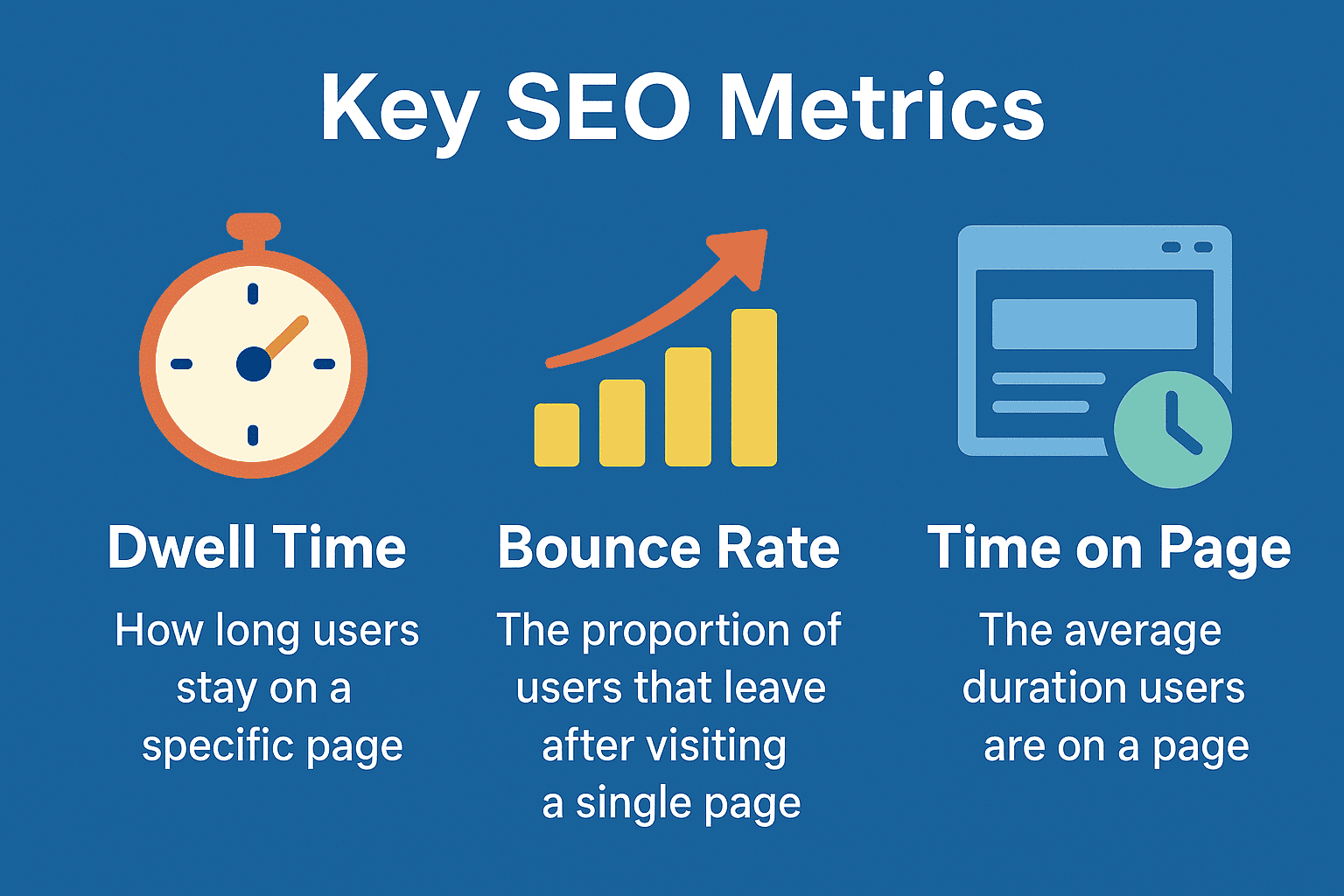
Dwell time is the exact time spent by a user on a website before leaving. The average time a user spends on a page or a website is commonly referred to as Time on Page. Bounce rate cannot have a dwell time, but exit rate often comes with an accurate time measurement.
By giving visitors what they need and making them feel comfortable, marketers can reduce bounce rate and increase dwell time.
However, you cannot completely eliminate a bounce rate, i.e., make it equal zero; it occurs naturally even for the most successful websites. Instead, aim to minimize it to a healthy level.
Depending on your niche and industry, that level may differ, according to the latest data:
- Content websites / blogs: 60–80% is common, since visitors often come for a single article.
- E-commerce sites: 20–45% is considered healthy, because users usually browse multiple products.
- Lead generation / landing pages: 40–60% is typical, though some high-performing landing pages can be lower if they guide users to a form.
- Service websites: 30–55% is a usual range, depending on how well the site funnels visitors to key actions.
Why it matters
The goal of every marketer is to make visitors stay on a website or page, either commercial or educational/informational, and to complete a meaningful action (the subject of our next chapter — about conversion rate).
Tracking dwell time and bounce rates on a regular basis provides marketers and SEO practitioners with the necessary information to test their assumptions and give insights to site owners and other decision-makers.
For instance, by monitoring dwell time, marketers can understand which content engages users and inspires them to stay longer on a website. They’ll get rid of the junk content and increase or improve the quality of the copy, video, and graphics that make users stay longer.
By the same token, marketers can utilize bounce rate to A/B test different designs and navigation elements, so that users intuitively understand where to click next and find what they came for.
How to measure it
Start with a simple GA4. Use the Organic Search default channel to isolate sessions, then review Engagement rate, Average engagement time, and Engaged sessions by landing page. The Bounce rate of 100% = Engagement rate for a clean proxy, since Google now prefers to use the term engagement rate instead of the bounce rate.
To approximate dwell time, focus on organic sessions’ average engagement time and pair it with scroll-depth and click events. Add Google Tag Manager events so you’re not guessing.
Marketers use the above-mentioned tools to report findings on a regular basis. By annotating content or UX changes, they can explain visitor movements.
Here is a quick memo for you on what to do:
- In GA4, track the Engagement rate (the bounce rate equals 100% minus engagement).
- Use Tag Manager to fire scroll-depth and time-on-page events reliably.
- Compare by device and template; investigate outliers with session replays for context.
- Annotate content changes, releases, and tests directly in dashboards.
Finally, it’s better to tie dwell proxy metrics to conversions. That way, you’ll know what works and what doesn’t on your customer journey on your website.
5. Conversion rate from organic search
Organic traffic coming from search engine results pages is a cheap and sustainable source of potential customers. However, do these visitors actually convert? Do they perform actions that the site owners want them to perform?
That’s where the conversion rate from organic search comes in. It’s one of the key metrics in website SEO, since it measures whether optimization efforts generate real, revenue-driving results.
What it is
In simple terms, the conversion rate from organic search is the share of unpaid search visitors who complete a desired action. Usually, it is displayed as a percentage of those who perform the expected action from those who don’t.
The desired actions may include:
- Sign-ups
- Purchases
- Demo requests
- Downloads
- Or any clear business-oriented action.
In the context of SEO KPIs, this sits among core SEO performance indicators because it links discovery to outcomes. It turns traffic into proof that your content and experience work.
Of course, it’s pleasing to see that your efforts pay off in the form of conversions. But even if that is not the case, the negative results you observe, when measurable, allow you to correct your efforts, to test and experiment with new approaches, designs, copies, landing pages, CTAs, and other elements.
👉 Think of conversion rate as a filter with a very fine sieve: many arrive, fewer act. Just like with the bourne rate discussed in the previous chapter, you cannot have a 100% conversion rate, i.e., it’s impossible to get rid of those who don’t convert. They’ll always be present, even in greater numbers than those who bounce off your site.
Why it matters
This rate separates those who bring value and revenue from those who don’t. For ecommerce sites, it reveals which pages bring buyers, not just readers. Conversion rate from organic traffic gives you the information and insights to make informed decisions and improve your offerings.
It’s also a trusted SEO success metric for leadership because it translates easily into revenue.
Without further ado, here are the core reasons why conversion rate matters:
- Turns SEO visibility into measurable business growth.
- Identifies pages and queries with real commercial intent.
- Prioritizes fixes on high-traffic, low-converting pages.
- Informs budget allocation across content and UX.
- Improves forecast accuracy for sales and finance.
Conversion rate readings represent a universal language for you to talk with your business functions, from sales to finance and top management.
For the management and marketers, a higher conversion rate signals a reduction in acquisition costs, helping to stabilize plans. It also shows that their content works harder without spending more.
How to measure it
Conversion rate measurement rewards sustainability and persistence. When you choose one primary conversion per page type and don’t change it often, it helps you see bigger trends over time.
To analyze user action patterns and explain behavior, you can use micro-conversions, filter performance by organic search only, and break down by device, country, demographic, or a particular landing page.
Consider taking these actions:
- Use Google Analytics 4 to set clear conversion goals and create an organic-only segment.
- Use Google Tag Manager to track key actions: form starts, form submits, and checkout steps.
- In Google Search Console, see which queries bring visitors to pages that convert.
- Compare mobile vs. desktop results to find and fix mobile-specific problems.
- Translate conversion gains into estimated revenue and write a short note on what worked.
Measurement without further action is a waste of time and resources. Even if your conversion rate is reasonably high, you should still analyze the negative results and develop actions that can bring you to even higher results the next time you measure your organic search conversion rate.
Each concrete action must have a responsible person (or a group of persons). Some actions will require more effort over a longer period of time, so consider setting up a project team to help drive positive results.
6. Backlink quality and domain authority
Search engines constantly scan and evaluate the web on different parameters. Domain authority and trust signals are among the top parameters that Google and other search engines value. The stronger the authority of a website, the higher its place in search engine results pages (SERPs) will be.
In this chapter, we’ll focus on the domain authority as the primary KPI in SEO, and explain what backlink quality has to do with it.
What it is
Among many other SEO key performance indicators, domain authority stands out because it reflects the overall strength and credibility of a website.
This KPI is one of the most studied and consistently measured by the leading software provider, Moz. Basically, they are the ones who created the term Domain Authority (DA). It’s their proprietary metric and one of their most well-known SEO KPIs. Moz updates DA regularly based on link profile strength, quality, and relevance.
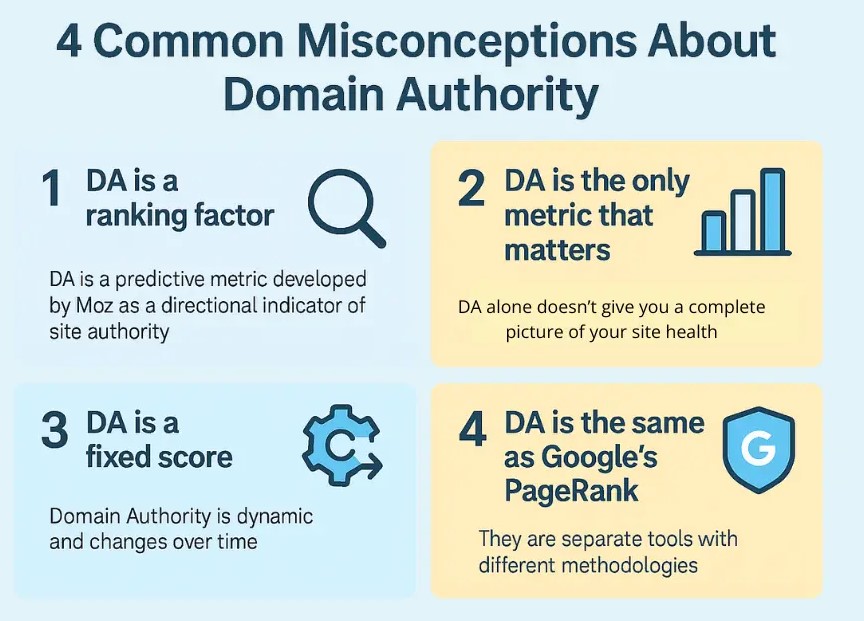
Source: Moz
Domain Authority is a practical shortcut for judging your starting position. It won’t tell you everything, but it helps answer, “Can we compete here today?” Higher DA usually means yes, or at least “maybe.”
👉 Quality backlinks help drive domain authority up. They act like wormholes in the webspace, transmitting trust and authority from one website to another.
Therefore, focus on winning links that make sense to readers. Reviews, case studies, data roundups, and expert quotes are reliable paths. Relevance and editorial placement are among the best drivers of success in this undertaking.
So, quality backlinks aren’t accidents. They come from helpful resources, clear research, useful tools, and relationships built in your niche. That kind of signal is hard to fake.
Remember to always keep DA in your toolkit, but never put it on a pedestal. It’s a practical KPI that’s great for benchmarking and goal setting, but the win is real users finding what they need — and doing something that matters.
Why it matters
DA is a very useful KPI. It gives you a quick read on “how much push” a page might need. It helps you budget effort between content, links, and UX fixes.
Also, when DA rises, your margin for error improves. You’re less dependent on perfect headlines or lucky timing.
Here are several reasons why DA matters in SEO:
- Clarifies when to build assets (tools, research) for mentions.
- Helps balance internal links from strong to weak sections.
- Improves discovery for new or updated pages.
- Makes outreach pitches more attractive to editors.
- Helps identify which competitors are actually beatable.
- Supports long-term SEO investment cases.
Use DA to set stepping-stone goals: win mid-tier terms, then move up to higher-tier terms. Pair it with content quality and user experience to turn authority into tangible outcomes.
👉 Remember: DA and backlinks open doors; relevance walks through them. Keep solving real search problems, so authority turns into real wins.
How to measure it
Not all backlinks are useful. To separate the ones that bring real value from the rest, use the following evaluation framework:
- Relevance of the linking site: A backlink from a site in your niche (e.g., a fitness blog linking to a gym site) is worth far more than a random, unrelated site.
- Placement of the link: Contextual links placed inside the main text carry more weight than links in the introduction, conclusion, or in the footer (header).
- Authority of the linking site: Check the linking site’s Domain Authority (Moz), Domain Rating (Ahrefs), or Trust Flow (Majestic).
- Anchor text: An anchor text that helps the reader to understand the meaning or the context better signals more trust to search engines than a generic one. For example, “a 10-minute daily workout” is better than “find more details here”.
- Diversity: Backlinks should come from various sources, e.g., news portals, social media pages, directories, blogs, industry sites, etc. Always prefer a natural mix of sources to a single one, even if it is authoritative.
Also, more mediocre-quality backlinks are not better than fewer, but higher-quality ones. So, plan your link-building strategy with these recommendations in mind.
👉 Tools to use: Choose Ahrefs, Moz, Majestic, or SEMrush for in-depth backlink analysis, or free options like Search Console for basic backlink statistics.
7. Page load speed and Core Web Vitals
SEO performance and Google ranking also depend upon a user’s comfort level on one’s site. In other words, when your visitors’ experience is good, you stand a better chance of ranking higher in SERPs.
Google and other search engines continuously evaluate your page load speed and other Core Web Vitals. That’s why we included them in our overview of SEO KPIs, and in this chapter, we’ll tell you everything about these metrics.
What it is
Page load speed is about how fast your page loads on users’ devices. The faster, the better, as modern users are impatient and not willing to wait for too long.
The Core Web Vitals are a set of critical website performance indicators used by Google to further evaluate the UX of your site. They are often referred to as technical KPIs in SEO.
Core Web Vitals consist of the following elements:
- Largest Contentful Paint (LCP) – measures loading performance. It looks at how long it takes for the main content (like an image or text block) to load and be visible. A “good” LCP is under 2.5 seconds.
- First Input Delay (FID) → soon replaced by Interaction to Next Paint (INP) – measures interactivity. It checks how quickly the page responds when a user first clicks, taps, or presses a key. A “good” FID is under 100 milliseconds.
- Cumulative Layout Shift (CLS) – measures visual stability. It tracks how many elements move around on the page as it loads (like buttons shifting suddenly). A “good” CLS score is less than 0.1.
👉 Together, Core Web Vitals are part of Google’s ranking signals. That means improving them not only helps users have a smoother experience but can also give you an edge in search results.
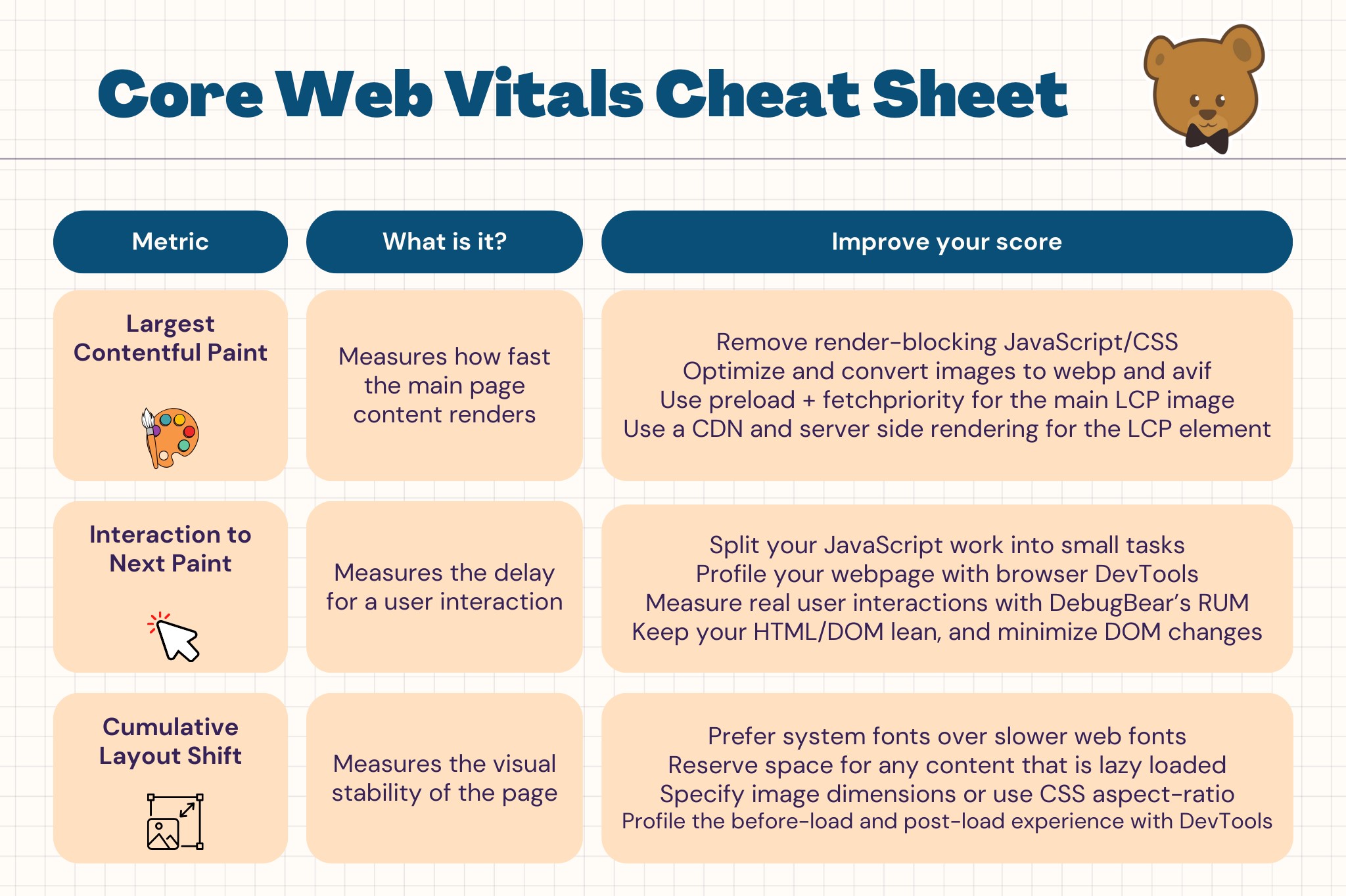
Source: DebugBear
Why it matters
Great content needs a great delivery. If the frame stutters, the story is lost. A balance between quality, detail, and speed is what you should strive to achieve.
Core Web Vitals measure delivery quality in plain terms: load, interact, and stability. Raise them, and everything else gets easier. Users are happy, and search engines notice that and rank your pages higher in SERPs.
Here’s why it matters:
- Faster pages amplify all marketing traffic.
- Improved interactivity reduces funnel friction.
- Stable UI increases confidence in payments.
- Strong vitals improve ad quality scores and Cost Per Click (CPC) efficiency.
- Better UX supports higher lifetime value.
👉 Pro tip: Set a “performance budget” for every page on your website to make optimizations measurable. Here are several examples of what you can do: limit JavaScript size, compress images to keep them light, or restrict third-party scripts.
These simple things prevent hidden slowdowns of your website and help individual pages load consistently fast.
How to measure it
Use Search Console to spot which page groups fail Core Web Vitals most often. That tool is free of charge, but it does take some time to get used to.
Once you get comfortable with that and want something more granular, run PageSpeed Insights (PSI) and Lighthouse on a few representative pages per template. It will enable you to fix the common issues first; they usually repeat.
Here is a simple routine to bookmark:
- Audit Core Web Vitals in Search Console weekly.
- Use DevTools Performance panel to find long main-thread tasks.
- PSI: identify the LCP resource and optimize delivery.
- Lighthouse: check font loading and critical CSS inlining.
- Run Real User Monitoring (RUM) via the Web Vitals library for live regressions.
👉 Pro tip: Break up long JavaScript tasks (>50ms) with code-splitting and scheduling (e.g., requestIdleCallback) to improve the Interaction to Next Paint (INP) parameter without feature cuts.
8. Mobile SEO KPIs
Today, mobile internet usage is booming. In fact, data shows that 96.5% of people access the internet using a mobile device. The economic sectors with the highest usage are ecommerce, entertainment, and finance.
These trends make mobile SEO key performance indicators an absolute must-have for any website or ecommerce shop. In this chapter, we explain what they are and how to measure them.
What it is
Mobile KPIs SEO cover discovery, speed, usability, and outcomes on phones. They are specific to mobile constraints and habits.
Typical metrics include:
- Mobile click-through rate (CTR);
- Mobile rankings;
- Largest Contentful Paint (LCP);
- Interaction to Next Paint (INP);
- Cumulative Layout Shift (CLS);
- Mobile conversion rate.
👉 Pro tip: If you need, you can also add “engaged sessions” for early validation and in-depth analysis.
All these SEO performance metrics show where friction hides. For instance, you can see if slow images or tiny tap targets block progress. Then you can bring examples to planning: “Reduce hero image size; recheck LCP and CTR.”
Why it matters
Mobile is often the first and only touchpoint. If the first impression is poor, users seldom try again on a desktop.
Search engines also rely on mobile performance to judge quality and eligibility. Without exaggeration, your entire website’s SERP ranking depends on mobile performance.
Win in this category, and you’ll instantly reduce bounce rate and increase dwell time, with conversion growing and revenues going up.
For those not convinced yet, here are the core reasons mobile KPIs matter:
- Faster pages lead to more reading and exploring.
- Clear, specific titles improve mobile CTR.
- Better INP makes menus and filters feel responsive.
- Stable layouts prevent costly mis-taps.
- Mobile conversions prove business value from SEO.
This creates a healthier funnel from discovery to purchase. Every improvement supports the next step.
How to measure it
Look at mobile-only data first in Google Analytics or Google Search Console. Separate the brand from the non-brand to understand real discovery.
Use PSI (Google PageSpeed Insights — a free tool that analyzes a web page and shows how fast it loads for real users) for field metrics and Lighthouse to debug render blockers.
Note this light measurement plan:
- In GA4: Create a mobile organic segment and track conversions clearly.
- In GSC: Monitor mobile click-through rate, top queries, and landing pages.
- Use PageSpeed Insights/Lighthouse to identify slow content elements and heavy scripts blocking speed.
- Compare mobile vs. desktop conversion by template.
- Review device and country splits for weak markets.
👉 Pro tip: Finish your measurement by converting improvements into projected revenue. Share two examples of fixes with the largest impact on a meeting with the team, discuss, and replicate them.
Conclusion
SEO KPIs come in different forms and for different devices. With this diversity and complexity, you shouldn’t try to measure everything at once. That would be more about measuring metrics for the sake of measurement. You’ll end up with lots of data and a minimum value for the website/business.
Instead, pick a few KPIs that match your correct business goals and objectives, and aim to be really good and consistent at measuring them over time.
One often overlooked thing about KPIs is that they rarely stay the same, but evolve and change along with the search engines and the best SEO practices. The key metrics that work for your website today might not be the perfect fit for your website tomorrow.
Keep a keen eye on the latest technological trends, particularly in Google’s algorithms, and also watch for the changes in user behavior, so you can adapt your metrics before competitors outpace you. In the long run, focus plus flexibility always wins.







